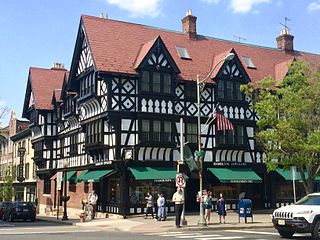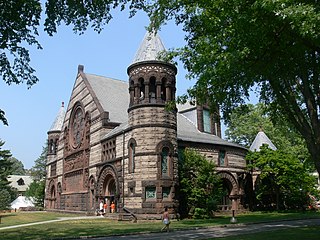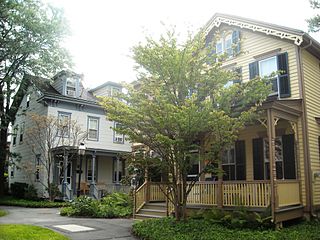
Princeton is a municipality with a borough form of government in Mercer County, in the U.S. state of New Jersey. It was established on January 1, 2013, through the consolidation of the Borough of Princeton and Princeton Township, both of which are now defunct. As of the 2020 United States census, the borough's population was 30,681, an increase of 2,109 (+7.4%) from the 2010 census combined count of 28,572. In the 2000 census, the two communities had a total population of 30,230, with 14,203 residents in the borough and 16,027 in the township.

John Witherspoon was a Scottish-American Presbyterian minister, educator, farmer, slaveholder, and a Founding Father of the United States. Witherspoon embraced the concepts of Scottish common sense realism, and while president of the College of New Jersey became an influential figure in the development of the United States' national character. Politically active, Witherspoon was a delegate from New Jersey to the Second Continental Congress and a signatory to the July 4, 1776, Declaration of Independence. He was the only active clergyman and the only college president to sign the Declaration. Later, he signed the Articles of Confederation and supported ratification of the Constitution of the United States.

Drew University is a private university in Madison, New Jersey. Drew has been nicknamed the "University in the Forest" because of its wooded 186-acre (75 ha) campus. As of fall 2020, more than 2,200 students were pursuing degrees at the university's three schools.

Princeton Theological Seminary (PTSem), officially The Theological Seminary of the Presbyterian Church, is a private school of theology in Princeton, New Jersey. Founded in 1812 under the auspices of Archibald Alexander, the General Assembly of the Presbyterian Church (USA), and the College of New Jersey, it is the second-oldest seminary in the United States. It is also the largest of ten seminaries associated with the Presbyterian Church.

New Brunswick Theological Seminary is a Reformed Christian seminary with its main campus in New Brunswick, New Jersey. It was founded in 1784 and is one of the oldest seminaries in the United States. It is a seminary of the Reformed Church in America (RCA), a mainline Reformed Protestant denomination in Canada and the United States that follows the theological tradition and Christian practice of John Calvin. First established in New York City under the leadership of the Rev. John Henry Livingston, who instructed aspiring ministers in his home, the seminary established its presence in New Brunswick in 1810. Although a separate institution, the seminary's early development in New Brunswick was closely connected with that of Rutgers University before establishing its own campus in the city in 1856. Since 1986, the seminary has also offered classes at a satellite location on the grounds of St. John's University in the Jamaica neighborhood of Queens, New York.

Westminster Choir College (WCC) is a historic conservatory of music currently operating on the campus of Rider University in Lawrenceville, New Jersey. Rider's College of Arts and Sciences, the college under which the historic institution has been reorganized, consists of Westminster Choir College as well as three additional schools.

The Nassau Presbyterian Church is a historic congregation located at 61 Nassau Street in Princeton, New Jersey, United States. It has been the home of many important figures in the history of Presbyterianism in the United States as a result of its proximity to Princeton University and the Princeton Theological Seminary. The church operates the Princeton Cemetery and is a contributing property to the Princeton Historic District. The current pastor is The Reverend Dr. David A. Davis.

Columbia University Libraries is the library system of Columbia University and one of the largest academic library systems in North America. With 15.0 million volumes and over 160,000 journals and serials, as well as extensive electronic resources, manuscripts, rare books, microforms, maps, and graphic and audio-visual materials, it is the fifth-largest academic library in the United States and the largest academic library in the State of New York. Additionally, the closely affiliated Jewish Theological Seminary Library holds over 400,000 volumes, which combined makes the Columbia University Libraries the third-largest academic library, and the second-largest private library in the United States.

Old Queens is the oldest extant building at Rutgers University and is the symbolic heart of the university's campus in New Brunswick in Middlesex County, New Jersey in the United States. Rutgers, the eighth-oldest college in the United States, was founded in 1766 during the American colonial period as Queen's College. Queen's College was named for Charlotte of Mecklenburg-Strelitz, the daughter of a German duke who became the queen consort of British king George III. Old Queens is located on a six-acre hilltop city block bounded by Somerset Street, Hamilton Street, College Avenue and George Street that was previously an apple orchard. Donated to the college in 1807 by James Parker, Jr., this city block become known the Queen's Campus and is the historic core of the university. Because of this, by metonymy, the name "Old Queens" came to be used as a reference to Rutgers College and is often invoked as an allusive reference to the university or to its administration.

Voorhees Mall is a large grassy area with stately shade trees on a block of about 28 acres (0.11 km²) located on the College Avenue Campus of Rutgers University near downtown New Brunswick, New Jersey. An eclectic mix of architectural styles, Voorhees Mall is lined by many historic academic buildings. The block is bound by Hamilton Street, George Street (north), College Avenue (south) and Seminary Place (west). At the mall's western end, across Seminary Place, is the campus of the New Brunswick Theological Seminary, whose history is intertwined with the early history of Rutgers University. Across Hamilton Street is the block called Old Queens, the seat of the university.
Princeton University was founded in Elizabeth, New Jersey, in 1746 as the College of New Jersey, shortly before moving into the newly built Nassau Hall in Princeton. In 1783, for about four months Nassau Hall hosted the United States Congress, and many of the students went on to become leaders of the young republic.

William Appleton Potter was an American architect who designed numerous buildings for Princeton University, as well as municipal offices and churches. He served as a Supervising Architect of the Treasury from 1874 to 1877.

John Maclean Jr., D.D. was an American Presbyterian clergyman and educator who served as the tenth President of Princeton University, then known as the College of New Jersey. Maclean, the son of the first professor of chemistry at the College of New Jersey, grew up in Princeton, New Jersey. He attended the College and later Princeton Theological Seminary. At age 23, he became full professor of mathematics at the university. Six years later, he became university vice president. He was responsible for bringing a number of renown scholars and academics to the college. During this time, he also left mathematics and became professor of ancient languages. Maclean was one of the chief architects of the state's public education system. His plan for a state normal school, local boards of education and nonsectarian public schools was adopted by the state legislature. He became president of the College of New Jersey in 1854. He led the university through the 1855 burning of Nassau Hall and the American Civil War. After retiring from his post after 14 years in office, he wrote a two-volume history of the university. He served as the honorary president of the university's Alumni Association until his death.
Charles Rosenbury Erdman Sr. (1866-1960) was an American Presbyterian minister and professor of theology at Princeton Theological Seminary.

John Cleve Green was a merchant and former partner of John Murray Forbes in the China trading house of Russell & Company. Green was a major benefactor of Princeton University and the Lawrenceville School, giving upwards of 1.5 million dollars, perhaps 2 million, to Princeton. On his death he also made major bequests to New York University and New York area hospitals.
Princeton Community Television is a Public, educational, and government access (PEG) cable TV channels in Princeton, New Jersey. The station provides camera equipment, TV studios and training that allow the community to create television shows, films, and other projects. The station is carried on Comcast channel 30 and Verizon FIOS channel 45 in the Princeton, New Jersey area. Princeton Community Television is one of the largest public producers of original content in New Jersey.

Richardson Auditorium in Alexander Hall is a historic 900-seat Richardsonian Romanesque performance hall at Princeton University in Princeton, New Jersey. It is home to both the Princeton University Orchestra and the Princeton Symphony Orchestra.

The Princeton Historic District is a 370-acre (150 ha) historic district located in Princeton, New Jersey that was listed on the U.S. National Register of Historic Places in 1975. It stretches from Marquand Park in the west to the Eating Clubs in the East, from the Princeton Cemetery in the north to the Graduate College in the south. The district encompasses the core parts of the campuses of the Princeton Theological Seminary and Princeton University. It also includes the business district centered on Nassau Street and many historic homes, both mansions in the western section and more humble dwellings in the Witherspoon/Jackson neighborhood. Notable churches within the district include Nassau Presbyterian Church, Trinity Episcopal, Nassau Christian Center, and the Princeton University Chapel. The district is home to seven of Princeton's nine, and New Jersey's fifty-eight, National Historic Landmarks, the largest concentration of such sites in the state.

Robert Leighton Stuart (1806–1882), with his brother Alexander (1810–1879), owned the New York sugar refining business of R. L. & A. Stuart. They were philanthropists who donated most of their money to charitable causes. Robert was one of the founders of the American Museum of Natural History and president from 1872 until 1881.
Witherspoon Street Presbyterian Church was founded in 1839 in Princeton, New Jersey. The church was formed after the Nassau Presbyterian Church allowed 90 of the 131 former African American members to form their own church, after a fire had devastated the Nassau church. The church is among New Jersey's oldest African American Presbyterian congregations.




















